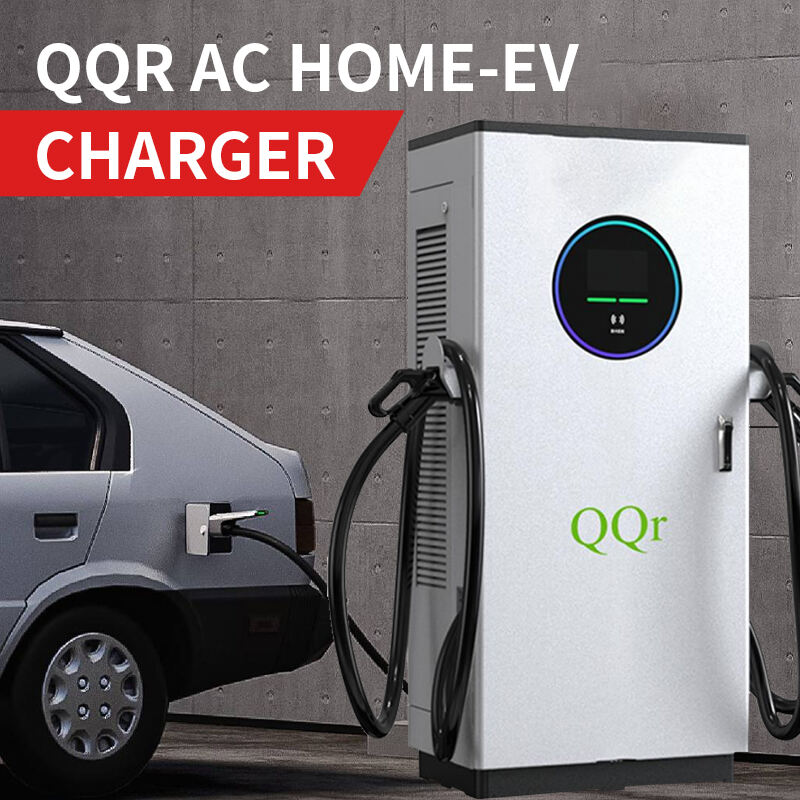Электромобильдерді бірқалыпты токпен зарядтау: зарядтау инфрақұрылымын кеңейтудің кілті
DC EV үйдеушілерін және олардың маңыздылығын түсіну
DC EV үйдеушілері - электр ауылдамалар технологиясындағы кеңес берілген шағын, AC қарсылықтарына салыстырғанда жылдам зарядтау уақытын береді. AC үйдеушілері, өзінде ауылдаманың бортқа конвертеріне сенімді болғандықтан, көп уақыт салысады, ал DC үйдеушілері ауылдаманың аккумуляторына тікелей ток энергиясын береді. Бұл әдіс EV экосистемасында маңызды, себебі ол ауылдаманы зарядтау үшін қажет болатын уақытты қайғымен азайтады, электр ауылдамаларды ұзақ мезгілді саяхат және күнделік пайдалануда қолайлырақ және ыңғайлырақ етеді.
DC EV үйдеушілерінің функционалдық процесі电网-тегінен (AC) ауыстырылған күшті (DC) ретінде шаруашылық станциясында ауыстыруға арналған. Бұл ауыстыру әлемдік станцияға аралас үйдеушісін өтпіз бастайды, батареяға тікелей енең өту мүмкіндігін береді. Нәтижесінде, DC жылдам үйдеушілер 50 kW-дан 350 kW-ға дейінгі енең деңгейлерін үйдеушінің және аралас қабілетіне байланысты қосады. Бұл қызметперіктік жүйе EV иесінің күтудің уақытын маңызды түрде кемиді, осылайша көптеген адамдарға электр араласын традиционалды қырыққабаттық моторларға негізделген альтернативалар ретінде қарастыруды қолдау береді.
DC EV Үйдеушілерін Қолданудың Негізгі Планауы Мəнfaatləri
DC EV үйкіткіштерін реалізетін қадамдар көп сияқты пайдаларға ие, ал бұл аралықта заряддау уақытын әсерлі түрде кеміту ең жауапты қасиеттерінің бірі. Салmeye аналитикалық зерттеулерге сәйкес, DC жылдам үйкіткіштері заряддау уақытын бірнеше сағаттан минуттарға дейін кемітуге мүмкіндік береді. Мисалы, кестелер мен үйкіткіш техникалық шарттарына байланысты, DC үйкіткіштері 20%-ден 80%-ке 20-30 минут ішінде заряддау мүмкіндігін ұсынады. Бұл заряддау уақытын әсерлі түрде кеміту электр аралар (EV) есімділеріне ыңғайлылық береді және сонымен қатар, қазіргі әлеуметтік қолданушылардың жылдам темпте өмір сыйлықтарына да сәйкес келеді.
Білік, DC EV зарядка станциаларының кеңейтуі пайдаланушылар үшін ыңғайлылықты арттырады, шағын қалалардың жолдау бөліктерінде зарядтау мүмкіндігін жеңілдетеді. Зарядка станциалары көбірек болғанда, EV пайдаланушылар стратегиялық орындарда, сондай-ақ алаңдар, аэропорттар және біріккендер сияқты орындарда жылдам зарядтау мүмкіндігін пайдаланады. Бұл пайдаланушылардың қаншылығын арттырады және заряддау қашықтығы туралы қорқындықты азайтады – бұл EV сатып алуды қарастыратын адамдар арасында танымал есептелетін сұрақ. Жылдам заряддау және DC заряддаудың беретін ыңғайлылық пен жылдамдыққа пайдаланушылар әдетте қаншылық көрсетеді деп зерттеулер әлі де көрсетеді.
Мәліметтерге сәйкес, DC электр ауыстырушыларының барлығы EV-дердің пайда болуын қолдайды. Бұл ауыстырушыларды қосу арқылы кеңес берулер инфраструктура жасайды, оларға көп адамдар электр ауыстырушыларға ауысуға мүмкіндік береді, ұранмен өзгертуді қалпына келтіреді. Инфраструктураның дамуы мүмкін EV пайдаланушыларына есептілік туралы қаттылық береді және әлемдегі ұранмен өзгертудің мақсаттарына сәйкес, карбон шығындарын кемітуге бағытталады. DC EV ауыстырушыларын қолдану EV-дердің кеңірек қабылдауын қолдайды және одан кейінгі ұранмен өзгертудің қызылтқысындағы, ұранмен өзгертудің зердеуін қалыптастырады.
DC EV Ауыстырушыларын Infrastructuraға Қосу
DC EV үйдеуіншілерді инфраструктураныza интегрциялау, электр емгіліктік жобалаудың талаптарына және орын алғашылықтарына сай болжамдау қажет. Бұл үйлеу, мезгілдік электр емгіліктік қабілетті талдаумен басталады, сонымен қатар қосымша жүкке сай болу үшін қайта жобалау керек пе талдауында болады. Орын алғашылықтар да маңызды, өйткені орналасуы қолайлы болуы керек және зарядтау құрал-жабдықтарын сақтау үшін жылжымалдық потоқын азайтусыз жеткілікті орын болуы тиіс.
Пайдаланушылардың біріктіру қажеттері мен күтуге дейінгі аралықтағы электр ауыр әлемдердің түрлеріне сай қандай дәрежедегі шакты және коннектор түрін таңдау маңызды. Пайдаланушы демографиясына байланысты, олар седан немесе үлкен электр грузовики әртүрлілерін қолданатын болса, шакты 50 kW-ден 350 kW-ға дейін әртүрлі болуы мүмкін. CHAdeMO, CCS немесе Tesla-ның өзара жұмыс істейтін коннекторы сияқты коннектор түрлері де, пайдаланушыларыңызға сай болуына байланысты қарастырылады.
Инфраструктураның жаңартуын қойылатын баптауларға DC зарядтау станцияларын орналастыруда маңызды қатынасқа ие болуы керек, электр желінің емгілетін қабілеті мен қажет болатын өзгерістерге негізделген. Бұл трансформаторларды немесе желі сәйкесінділерін жаңартуға дейін болуы мүмкін, көбірек жүк сұранысын қабылдау үшін. Сондай-ақ, ортақ құқықтарға сәйкес келу және қажетті лицензияларды алу EV зарядтау станцияларын орналастыру процесінің тез және ыңғайлы болуы үшін маңызды. Бұл аспекттерді жақсарту арқылы инфраструктураныз DC электромобилдерді зарядтау үшін тиімді түрде қолдауға жеткілікті болады.
DC электромобілдерді зарядтау үшін қаржылық талаптар
DC EV зарядкалық станциялар үшін қаржылық талаптарды түсіну, оларды инфраструктураға қосу жөніндегі сапарлары бар бизнесдер үшін маңызды. Бастапқы қаржы зарядка апараттарын сатып алуды және оларды орналастыруға байланысты, оның құны марка, емдігі және инфраструктура талаптарына байланысты өзгеруі мүмкін. Орташаға, бизнеслер әдетте 10,000 доллардан 40,000 долларға дейінгі қаржыны көздей алады, бұл электр қосымшаларының қаржысы мен зарядкалық аппараттарды табиғи системаларға қосу құнында қамтамасыз етеді. Бұл кең қаржы сайтының себебі әрбір орналасуының атақты талаптары, ортақ шығын қызметтерінің бағасы және қажетті земекөршілік деңгейі болып табылады.
Сақтау және эксплуатация қаржылары да бағалануы керек. DC EV зарядтаушыларды қозғалтудың негізгі қаржылары электр энергиясын қамтиды, оның өрткіш бір kWh-ға 13 тенге екені шығарылған, бұл орналасуы мен пайдаланудың негізінде өзгереді. Өмірбаян қызметтердің маңыздылығы оптималды жұмыс беруін сақтау үшін қажет және жыл сайын бір зарядтаушы бойынша $400-ден $1,000-ге дейін өзгеруге болады. Бұл тиімді тексерулер, программаларды жаңарту және қызметтер, неожидан ауыстырулардан қорғау және зарядтаушылардың жылдамдығын ұзағайтын әрекеттерді қамтамасыз етеді.
Көшірмелі, DC EV үйдеу кезінде жылдам толықтыру апараттары әкелімдерге қосымша есептік жол болып табылады, бірнеше бағалау моделдері арқылы мүмкін шағын қайта алу мүмкіндігін береді. Бізнес субьекттері минут бойына немесе kWh бойына есептеу таңдауы мүмкін, әрбірі әкелімге әсер етуі мүмкін. Зерттеулер нәтижесінде, көшірме жылдамдығы мен ортаға демографикалық факторларға байланысты, бизнес $0.30-ден $0.40 kWh бойына пайдаланушылардан төлеуді талап ету арқылы кереметтікке жетуге болады. Осы моделдер не тек бастапқы қызметтерді қайта алуды, бірақ EV иеулерін қоршаған орынға шеккенде брендтік дегенмен туралы да қолдау береді.
Жоғары деңгейдегі DC EV үйдеу апараттарын зерттеу
240KW Ультра-жылдам DC EV үйдеу
240KW Ультра-Жыл ЕК ДС ЕВ Зарядкалық станциясы коммерциялық және көмірек пайдалану сценарилерінде биік талаптарға сай дайындалған. Биік қорғау дизайнімен, бұл зарядкалық станция әртүрлі ауа шарттарына қарсы ыңғайлы, әртүрлі орталықтарда қаттылықпен жұмыс істей алады. Оның 7-дюймдік түскі экраны бар және карталарды жіберу және мобилді қосымшаларды пайдалану арқылы заряддауға бастау үшін көптеген әдістері бар. Интеллектуалды дизайны әзірлеу софтурының реаль уақыттағы жаңартуларын және оптималды заряддау стратегияларын қамтамасыз етеді, заряддаудың процесін ыңғайлы және қызметкерлік етеді.

480kW зарядтау станциясы
480кВт зарядная станция ашық орналасу жерлері және тяжелая коммерциялық қолданбалар үшін максаттағы таңдаулардың бойынша дайындалған. Бұл станция оптималды ресурстарды пайдалану үшін бөлінген дизайн пайдаланады, гибділік пен қызметкерлікті береді. Оның ішінде көптеген энергия автобус топологиялары бар, бұл жерге қарағандағы талаптарға сәйкес келетін адаптивдықты ұсынады. Станцияның дизайны реальдық уақыттағы деректерді мониторлау және басқару үшін сетке қосылу қабілетін қамтамасыз етеді.

GTD_N_120 ДС зарядтаушы
GTD_N_120 DC зарядкалық станция оңтүстік ыңғайлылықтары мен басқарудың кең таңдауларымен айрылады. Ол қолданбашы интерфейсі арқылы немесе картаны жіберу арқылы қолданушымен ыңғайлы өзараәмалдылықты taрғайды және динамикалық зарядтау стратегияларын қолдайды. Бұл зарядкалық станция 95% ыңғайлы етіп, энергияның ішкі қателерін азайтуға көмектеседі және электрлық және қоршаған ортаға қарсы қауіпсіздік қамтамасыз ету үшін көптеген қауіпсіздік қамтамасыз ету әдістерін қамтиді. Екі зарядкалық пистолеттері бар және гибкая вольтажтық өзгертулермен, бұл зарядкалық станция сірекке екі машинаны да бір уақытта зарядтау керек болатын орталықтар үшін идеалды.

Жалпы қателер туралы мисалдарды түсіндіру.
Бір танымал күтпеліс – ДС жылдам зарядтаушылардың ЭВ батареяларға қажетті зиян еткені. Эксперттердің және зерттеулердің деректері сипаттайды, ДС жылдам заряддау дағдылықтық өстігін жасай алады, теориясына сәйкес, бұл батареяның өзгеруін жылдамдетуге мүмкіндік береді, бірақ нақты әсерлері кез келгенде қабылданныңда азға шексіз. Мюлен Автомотив-тың CEO-і Давид Мишери ДС заряддаудағы жоғары күрделі токтардан пайда болатын мүмкін проблемаларды табысады. Бірақ, 6,500-ден астам Tesla Model 3-ке қатысты Recurrent тіркесінше зерттеулер, ДС жылдам зарядтаушыларды қолданатын және қолдамайтын әртүрлі ауырлықтар арасындағы батарея өзгеруінде негізгі айырмашылық жоқ екенін көрсетеді. Кешірме EV-дердің интеллектуалды заряддау мүмкіндіктері тәуелсіздікке жеткізу үшін тигізгі әсерлерді кемітуге көмектеседі, уақыт бойы батарея саудағын қорғайды.
Басқа бір миф DC жылдам зарядтау құрылғыларын басқарудың үшін шығадытын үлкен тиімдік тәсірлеріне байланысты. Бұл зарядтау құрылғыларының экономикалық өзгешелігі, әртүрлі салалardағы бизнесдер оларды қабылдау арқылы дәл көрсетілуде. Көптеген компаниялар EV пайдаланушыларының жылдам зарядтау шешімдеріне қатысты көбейтін талапқа сәйкес, қызметке сенімді қайтарым алуды қорытындылайды. Бастапқы тиімдік зарядтау төлеулері мен клиенттер санының артуы арқылы қазірден өтеді, осылайша DC жылдам зарядтау құрылғылары EV пазарының кеңейуіне қарағанда бизнес үшін қолайлы альтернатива болып табылады. Қолданба және уақыттық төлеулерді қамтидықтай қызмет көрсету моделдерін қолдану арқылы компаниялар операциялық тиімдіктерді әсерлі түрде басқаруға және конкурстармен беріспе қызметтер ұсынуға болады.
DC EV зарядтау қолданбаларындағы келешекті тенденцилар
ДС электромобілдердің шаруашылығы әсерлі технологиялық жетістіктерге себеп болып, тез өзгертілуі келесі. Шаруашылықтың және аккумулятор технологиясының жақсартылуы орташа қолжетімді пайдаланушы үшін электромобілдерді қызықтырту мен қолдастыруда маңызды. Солид-өмірлік аккумуляторлар және жаңартылған термалдық басқару системалары сияқты инновациялармен, зарядтау уақыты құтқарлы тәртіпте кемітуі күтемізде. Мәліметтердік инновациялар пайдаланушы тәжірибелерін жақсартып, әдеттегі интернет қосымшасына, реальдік уақыттағы заряд станциясының артықшылығына және ырыссыз төлем опцияларына мүмкіндік береді. Бұл жетістіктер зарядтау системаларымен қалай өзгеруге дейін, сонымен қатар барлық электромобілдік ейелдер үшін қызметкерлік пен қолдастықты жақсартады.
Қоғамдық саясаттар мен инфраструктураның дамуы, DC электр ауыстырылған әріптердің (EV) зарядтау желілерінің болашағын құруда маңызды rol атады. Мемлекеттік стимулдар, сол жерде салықтық көмектесулер және қайта төлеудің EV-жүйелерін және зарядтау технологияларын қолдануға бизнес пен қызметкерлерді тығыздайды. Стандарттау үшін зарядтау инфраструктурына қатысты қаншалықтықтар да құрылып жатыр, бұл әртүрлі жүйелер арасындағы интероперабельдікті ыңғайлауға көмектеседі. Кейбір мемлекеттік және международдық жоспарлар зарядтау инфраструктурын өте кеңірек кеңейтуге бағытталған, зарядтау станциялары қашық жерлерде де қолжетімді болуын tańдайды. Бұл стратегиялық інициативалар электр ауыстырылған әріптердің кеңірек қабылдауын ыңғайлатады, ол жеңіл әлемінде әдетте қажетті тұрақтылыққа қол жеткізумен бірге әрекет етеді. Саясаттар мен технологиялар әлі де дамып жатқан кезде, DC EV зарядтау күнделікті өмірде әлдеқайда ыңғайлас қысқартылады және көптеген адамдар үшін қол жетімді болады.

 EN
EN
 AR
AR
 BG
BG
 HR
HR
 CS
CS
 DA
DA
 NL
NL
 FI
FI
 FR
FR
 DE
DE
 IT
IT
 PL
PL
 PT
PT
 RO
RO
 RU
RU
 ES
ES
 SV
SV
 TL
TL
 IW
IW
 ID
ID
 LT
LT
 SR
SR
 SK
SK
 SL
SL
 VI
VI
 ET
ET
 HU
HU
 MT
MT
 TH
TH
 TR
TR
 AF
AF
 MS
MS
 GA
GA
 CY
CY
 HY
HY
 AZ
AZ
 KA
KA
 LA
LA
 KK
KK
 UZ
UZ
